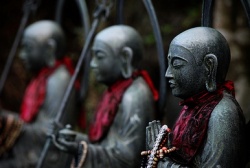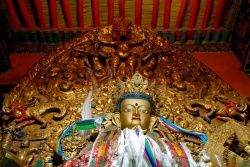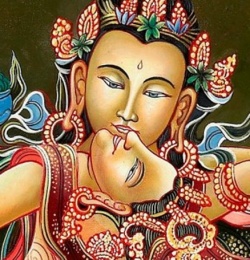Difference between revisions of "The Three Kāyas Sūtra"
(Created page with "thumb|250px| <poem> The Three Kāyas Sūtra In the Indian Language [Sanskrit]: Ārya Trikāya nāma Mahāyana Sūtra In the Tibetan Language: Phakpa Ku S...") |
m (Text replacement - "the Dharma" to "the Dharma") |
||
| (4 intermediate revisions by 2 users not shown) | |||
| Line 1: | Line 1: | ||
[[File:1 500.jpg|thumb|250px|]] | [[File:1 500.jpg|thumb|250px|]] | ||
<poem> | <poem> | ||
| − | The Three Kāyas Sūtra | + | [[The Three Kāyas Sūtra]] |
| − | In the Indian Language [Sanskrit]: Ārya Trikāya | + | In the [[Indian]] [[Language]] [[Sanskrit]]: [[Ārya]] [[Trikāya]] [[Nāma]] [[Mahāyana]] [[Sūtra]] |
| − | In the Tibetan Language: Phakpa Ku Sum zheyjaway Thekpachhenpo’i Do ['phags pa sku gsum zhes bya ba'i theg pa chen po'i mdo] | + | In the [[Tibetan]] [[Language]]: Phakpa Ku Sum zheyjaway Thekpachhenpo’i Do ['phags pa sku gsum zhes bya ba'i theg pa chen po'i mdo] |
| − | In the English Language: The Mahāyana Sūtra known as “The Exalted Three Kāyas” | + | In the English [[Language]]: The [[Mahāyana]] [[Sūtra]] known as “The [[Exalted]] Three Kāyas” |
| − | ADORATION TO ALL | + | ADORATION TO ALL [[Buddhas]] AND BODHISATTVAS. |
| − | Thus have I heard: At one time, the Transcendent and Accomplished Conqueror was abiding at Vulture’s Peak Mountain in Rājagriha. Immeasurably, innumerably many bodhisattvas, gods, | + | [[Thus have I heard]]: At one time, the [[Transcendent]] and Accomplished Conqueror was abiding at [[Vulture’s Peak]] Mountain in [[Rājagriha]]. Immeasurably, innumerably many [[bodhisattvas]], [[gods]], [[Nagas]], and retinues were all abiding together in one congregation, paying reverence and [[Making Offerings]] to the [[Transcendent]] and Accomplished Conqueror. |
| − | At that time, the Bodhisattva Kshitigarbha, who was sitting there in that assembly, rose from his seat, and then addressed the Transcendent and Accomplished Conqueror with the following words: | + | At that time, the [[Bodhisattva]] [[Kshitigarbha]], who was sitting there in that assembly, rose from his seat, and then addressed the [[Transcendent and Accomplished Conqueror]] with the following words: |
| − | “How many kāyas does the Bhagavān possess?” | + | “How many [[kāyas]] does the [[Bhagavān]] possess?” |
| − | The Transcendent and Accomplished Conqueror bestowed teaching thus: | + | The [[Transcendent]] and Accomplished Conqueror bestowed [[teaching]] thus: |
| − | + | “[[Kshitigarbha]], the [[Bhagavān]] [[Tathāgata]] possesses three [[kāyas]]: the [[Dharmakāya]], the [[Sambhogakāya]], and the [[Nirmaṇakāya]].” | |
| − | “Son of good lineage, concerning the Three Kāyas: Utterly pure essential nature is the Dharmakāya. Utterly pure | + | “Son of good [[lineage]], concerning the Three Kāyas: Utterly pure [[essential]] nature is the [[Dharmakāya]]. Utterly pure [[Meditative]] absorption is the [[Sambhogakāya]]. Utterly pure conduct is the [[Nirmaṇakāya]] of all [[Buddhas]].” |
[[File:1162C372.jpg|thumb|250px|]] | [[File:1162C372.jpg|thumb|250px|]] | ||
| − | “Son of good lineage, the Dharmakāya of the Tathāgata, like the sky, has the significance of the absence of inherent existence. The Sambhogakāya, like a cloud, has the significance of emergence. The Nirmaṇakāya is the | + | “Son of good [[lineage]], the [[Dharmakāya]] of the [[Tathāgata]], like the sky, has the significance of the absence of inherent [[existence]]. The [[Sambhogakāya]], like a cloud, has the significance of [[emergence]]. The [[Nirmaṇakāya]] is the [[Enlightened]] [[activity]] of all [[Buddhas]], and, like rain, has the significance of permeating everything.” |
| − | The Bodhisattva Kshitigarbha addressed the Transcendent and Accomplished Conqueror with the following words: | + | The [[Bodhisattva]] [[Kshitigarbha]] addressed the [[Transcendent]] and Accomplished Conqueror with the following words: |
| − | “How should one view the explanation of the Three Kāyas of the Bhagavān?” | + | “How should one [[view]] the explanation of the Three [[Kāyas]] of the [[Bhagavān]]?” |
| − | The Transcendent and Accomplished Conqueror bestowed teaching to the Bodhisattva Kshitigarbha thus: | + | The [[Transcendent]] and [[Accomplished Conqueror]] bestowed [[teaching]] to the [[Bodhisattva]] [[Kshitigarbha]] thus: |
| − | “Son of good lineage, one should view the Three Kāyas of the Tathāgata in the following way: One should view the Dharmakāya as that which is the true identity of the Tathāgatas. One should view the Sambhogakāya as that which is the true identity of the Bodhisattvas. One should view the Nirmaṇakāya as that which is the true identity of ordinary individuals who act with a sense of dedication1.” | + | “Son of good [[lineage]], one should [[view]] the Three [[Kāyas]] of the [[Tathāgata]] in the following way: One should [[view]] the [[Dharmakāya]] as that which is the true identity of the [[Tathāgatas]]. One should [[view]] the [[Sambhogakāya]] as that which is the true identity of the [[Bodhisattvas]]. One should [[view]] the [[Nirmaṇakāya]] as that which is the true identity of ordinary {{Wiki|individuals}} who act with a [[sense]] of dedication1.” |
| − | “Son of good lineage, the Dharmakāya dwells in | + | “Son of good [[lineage]], the [[Dharmakāya]] dwells in [[Harmony]] with all [[Buddhas]] and their [[essential]] nature. The [[Sambhogakāya]] dwells in [[Harmony]] with all [[Buddhas]] and their [[Meditative]] absorption. The [[Nirmaṇakāya]] dwells in [[Harmony]] with all [[Buddhas]] and their [[Enlightened]] [[activity]].” |
| − | “Son of good lineage, the transmutation of the storehouse | + | “Son of good [[lineage]], the transmutation of the storehouse [[Consciousness]] is Mirror-Like [[Wisdom]], and the [[Dharmakāya]]. The transmutation of the afflicted [[Mind]] is Equalizing [[Wisdom]]. The transmutation of the [[Mental]] [[Consciousness]] is Discriminating [[Wisdom]], and the [[Sambhogakāya]]. The transmutation of the [[consciousnesses]] of the five doors is Action-Accomplishing [[Wisdom]], and the [[Nirmaṇakāya]].” |
| − | Then, the Bodhisattva Kshitigarbha addressed the Transcendent and Accomplished Conqueror with the following words: | + | Then, the [[Bodhisattva]] [[Kshitigarbha]] addressed the [[Transcendent]] and Accomplished Conqueror with the following words: |
| − | + | “[[Bhagavān]], that I have heard the [[Sacred]] [[Dharma]] from the [[Bhagavān]] is extremely good. [[Sugata]], it is extremely good.” | |
| − | The Transcendent and Accomplished Conqueror bestowed teaching thus: | + | The [[Transcendent]] and Accomplished Conqueror bestowed [[teaching]] thus: |
[[File:Aces-28.jpg|thumb|250px|]] | [[File:Aces-28.jpg|thumb|250px|]] | ||
| − | “Son of good lineage, whosoever thoroughly retains this Dharma discourse of the Bhagavān shall obtain limitless, inexpressible, incalculable, and unfathomable | + | “Son of good [[lineage]], whosoever thoroughly retains this [[Dharma]] {{Wiki|discourse}} of the [[Bhagavān]] shall obtain limitless, inexpressible, incalculable, and unfathomable [[Merit]].” |
| − | The Transcendent and Accomplished Conqueror granted teaching with those words, and Bodhisattva Kshitigarbha, together with the worlds of gods, | + | The [[Transcendent]] and Accomplished Conqueror granted [[teaching]] with those words, and [[Bodhisattva]] [[Kshitigarbha]], together with the [[worlds]] of [[gods]], [[Nagas]], [[yakshas]], and [[gandharvas]], rejoiced, and deeply praised what had been spoken by the [[Transcendent]] and Accomplished Conqueror. |
THE MAHĀYANA SŪTRA KNOWN AS “THE EXALTED THREE KĀYAS” IS COMPLETE. | THE MAHĀYANA SŪTRA KNOWN AS “THE EXALTED THREE KĀYAS” IS COMPLETE. | ||
| − | Translated from Tibetan by Erick Tsiknopoulos | + | Translated from [[Tibetan]] by [[Erick Tsiknopoulos]] |
| − | in McLeod Ganj, Dharamsala, India; November 2012. | + | in McLeod Ganj, {{Wiki|Dharamsala}}, [[India]]; November 2012. |
| − | Thanks to Dr. Lobzang Gyamtso for his help with reviewing the translation and providing commentary and explanation for many points in the text. | + | Thanks to Dr. [[Lobzang Gyamtso]] for his help with reviewing the translation and providing commentary and explanation for many points in the text. |
| − | 1 Generally, this means beings who are dedicated in their practice of the Dharma, but who have not yet attained the | + | 1 Generally, this means [[beings]] who are dedicated in their practice of the [[Dharma]], but who have not yet attained the [[Bodhisattva]] levels, in particular those on the [[Path]] of Accumulation and the [[Path]] of Application, before the the first [[Bodhisattva]] level is attained. They “act with a [[sense]] of [[dedication]]” because they have not yet manifestly [[realized]] [[Emptiness]], and practice out of that [[dedication]] supported by the teachings, {{Wiki|conceptual}} frameworks, and devotion. However, in the context of this [[Sutra]], it could apply to anyone who is not yet (or at least not evidently) a [[Bodhisattva]], but who is dedicated to their [[Dharma]] practice or study. The [[Nirmaṇakāya]] [[manifests]] itself as such [[people]], who appear ordinary but are, in [[reality]], [[Emanations of the Buddha]]. |
</poem> | </poem> | ||
{{R}} | {{R}} | ||
Latest revision as of 17:11, 12 September 2013
The Three Kāyas Sūtra
In the Indian Language Sanskrit: Ārya Trikāya Nāma Mahāyana Sūtra
In the Tibetan Language: Phakpa Ku Sum zheyjaway Thekpachhenpo’i Do ['phags pa sku gsum zhes bya ba'i theg pa chen po'i mdo]
In the English Language: The Mahāyana Sūtra known as “The Exalted Three Kāyas”
ADORATION TO ALL Buddhas AND BODHISATTVAS.
Thus have I heard: At one time, the Transcendent and Accomplished Conqueror was abiding at Vulture’s Peak Mountain in Rājagriha. Immeasurably, innumerably many bodhisattvas, gods, Nagas, and retinues were all abiding together in one congregation, paying reverence and Making Offerings to the Transcendent and Accomplished Conqueror.
At that time, the Bodhisattva Kshitigarbha, who was sitting there in that assembly, rose from his seat, and then addressed the Transcendent and Accomplished Conqueror with the following words:
“How many kāyas does the Bhagavān possess?”
The Transcendent and Accomplished Conqueror bestowed teaching thus:
“Kshitigarbha, the Bhagavān Tathāgata possesses three kāyas: the Dharmakāya, the Sambhogakāya, and the Nirmaṇakāya.”
“Son of good lineage, concerning the Three Kāyas: Utterly pure essential nature is the Dharmakāya. Utterly pure Meditative absorption is the Sambhogakāya. Utterly pure conduct is the Nirmaṇakāya of all Buddhas.”
“Son of good lineage, the Dharmakāya of the Tathāgata, like the sky, has the significance of the absence of inherent existence. The Sambhogakāya, like a cloud, has the significance of emergence. The Nirmaṇakāya is the Enlightened activity of all Buddhas, and, like rain, has the significance of permeating everything.”
The Bodhisattva Kshitigarbha addressed the Transcendent and Accomplished Conqueror with the following words:
“How should one view the explanation of the Three Kāyas of the Bhagavān?”
The Transcendent and Accomplished Conqueror bestowed teaching to the Bodhisattva Kshitigarbha thus:
“Son of good lineage, one should view the Three Kāyas of the Tathāgata in the following way: One should view the Dharmakāya as that which is the true identity of the Tathāgatas. One should view the Sambhogakāya as that which is the true identity of the Bodhisattvas. One should view the Nirmaṇakāya as that which is the true identity of ordinary individuals who act with a sense of dedication1.”
“Son of good lineage, the Dharmakāya dwells in Harmony with all Buddhas and their essential nature. The Sambhogakāya dwells in Harmony with all Buddhas and their Meditative absorption. The Nirmaṇakāya dwells in Harmony with all Buddhas and their Enlightened activity.”
“Son of good lineage, the transmutation of the storehouse Consciousness is Mirror-Like Wisdom, and the Dharmakāya. The transmutation of the afflicted Mind is Equalizing Wisdom. The transmutation of the Mental Consciousness is Discriminating Wisdom, and the Sambhogakāya. The transmutation of the consciousnesses of the five doors is Action-Accomplishing Wisdom, and the Nirmaṇakāya.”
Then, the Bodhisattva Kshitigarbha addressed the Transcendent and Accomplished Conqueror with the following words:
“Bhagavān, that I have heard the Sacred Dharma from the Bhagavān is extremely good. Sugata, it is extremely good.”
The Transcendent and Accomplished Conqueror bestowed teaching thus:
“Son of good lineage, whosoever thoroughly retains this Dharma discourse of the Bhagavān shall obtain limitless, inexpressible, incalculable, and unfathomable Merit.”
The Transcendent and Accomplished Conqueror granted teaching with those words, and Bodhisattva Kshitigarbha, together with the worlds of gods, Nagas, yakshas, and gandharvas, rejoiced, and deeply praised what had been spoken by the Transcendent and Accomplished Conqueror.
THE MAHĀYANA SŪTRA KNOWN AS “THE EXALTED THREE KĀYAS” IS COMPLETE.
Translated from Tibetan by Erick Tsiknopoulos
in McLeod Ganj, Dharamsala, India; November 2012.
Thanks to Dr. Lobzang Gyamtso for his help with reviewing the translation and providing commentary and explanation for many points in the text.
1 Generally, this means beings who are dedicated in their practice of the Dharma, but who have not yet attained the Bodhisattva levels, in particular those on the Path of Accumulation and the Path of Application, before the the first Bodhisattva level is attained. They “act with a sense of dedication” because they have not yet manifestly realized Emptiness, and practice out of that dedication supported by the teachings, conceptual frameworks, and devotion. However, in the context of this Sutra, it could apply to anyone who is not yet (or at least not evidently) a Bodhisattva, but who is dedicated to their Dharma practice or study. The Nirmaṇakāya manifests itself as such people, who appear ordinary but are, in reality, Emanations of the Buddha.


